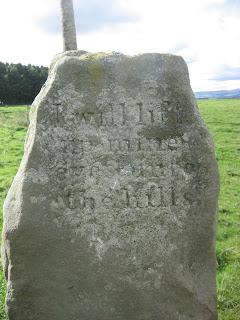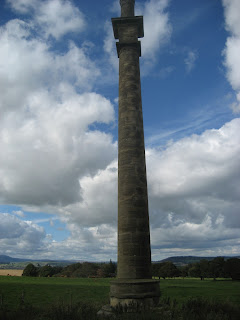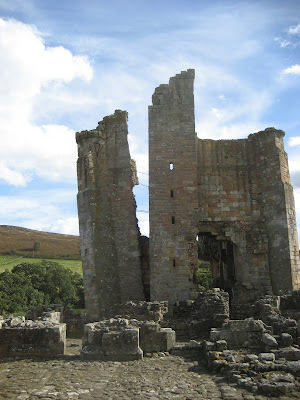Almost the Bizzle.........September 28th
The Cheviot is a long extinct volcano, fortunately, or Wooler could be the Pompeii of north east England. On the north side of the Cheviot are three gashes cut into its side by glacial action some 12000 years ago. They are the Henhole, (See The Henhole September 23rd 2011) the Bizzle and Bellyside.
There has been yet another bout of heavy rain in the north of England this week. Homes in Newcastle and Morpeth have been flooded and all rivers are swollen, nevertheless we have decided to walk in the hills this week and to ascend the Bizzle. ( I tried to find a meaning for this word but Google could only offer a pop group or a sexual practice and neither seemed really appropriate. I'm guessing but could it possibly be derived from birce, an Old English word for birch, a common tree in the area. Let's hope some expert reads this and supplies an answer.)
There are five gadgie plebs out today, plus Ray who claims to be a prole. I secretly think I am patrician but having been born in a two up two down terrace house in Yorkshire without electricity and brought up on a council estate (Social Housing today) in Lancashire it seems a rather tenuous idea. Six of us, the luxury of two cars!
To get to the start of the walk, in the Harthope Valley, A1, A697, turn off into Wooler, take the first on the left, (tight turn), past the village hall and the YHA, take the right fork, turn right at the sign for LANGLEEFORD, past the delightfully named Skirlnaked (from Shrieknaked, a reference to its exposed position!) At the end of the valley thare is a parking area on the left.
A map for this walk is useful, take OL16 The Cheviot Hills. The car park is at GR953225.
Doesn't look much look like a car park but it is, slightly soggy today.
Pictorial evidence of its status as car park. Yes, they are Rohan shades.
We followed the path across the road that leads up Hawsen Burn. In spring we have seen Ring Ousels up this burn, and adders too, bare feet are not to be recommended. The path leads uphill quite steadily to a style in the fence on the shoulder between Hawsen Crags and Blackseat Hill. The path down from the style is muddy at the best of times but surprisingly, considering the recent heavy rain, it was no worse than usual. Meeting a track we turned rigjht and walked along it a short way before taking the path through a plantation. Emerging from the wood we crossed a couple of fields and a stream as we approached the farm at Goldscleugh. ( No mines I'm afraid; probably "Golda's Cleugh" the latter word meaning ravine.)
The old farm house at Goldscleugh. It appears to be used as a store now, a newer house
is on the right.
Goldscleugh is the last building in the valley and therefore the end of the metalled road, the next park of the walk, which took us to Dunsdale about one mile away.
Dunsdale is another valley farm house but the building is used as a holiday cottage, probably a great place to stay, central for walks, isolated from the world.
Dunsdale means Hill and Valley, it's at the foot of a hill
in the valley.
From Dunsdale we were intending to walk up the Bizzle itself, which has a long walk in followed by a climb and scramble out, but for some reason we took the path on the tongue between Bellyside Burn and the Bizzle itself. Walking close to the edge of the Bizzle we followed a path for the best part of two miles, climbing steeply at times until we reached Bellyside Crag. Half way up, looking into the valley of the Bizzle, Dave, wearing his geologist's hat stopped us and pointed out that experts thought this was the site of the last glacier in England, which had retreated about 11700 years ago.
Looking into the site of the last English Glacier.
Heading up from Dunsdale. I think that the cairn to the left of the plebs
is the remains of a memorial to servicemen killed in wartime plane crashes
on the hills.
The views from this hill are worth the effort, the College Valley beneath you, which is my favourite valley in the Cheviots, and panoramic views into Scotland and across Northumberland to the sea.
We lunched at Bellyside Crags. Bellyside comes from either Old English for hill or Norman French for pretty) For once nobody had brought pies but two of us had ginger biscuits, Ben's homemade melt in the mouth slightly spiced wonders and Ringtons gingers which are generally considered to be among the best mass produced biscuits.
Close to the crag was an interesting looking device. Like a large witches cauldron it had a solar panel on one side, facing south. On the top were two rectangular pieces of plastic which bent in the wind and it appeared there had once been four of these, placed on the arms of a cross. Inside the cauldron were a number of egg boxes and wires were connected to the arms of the cross. My idea was that it was somebody's Ph. D experiment into wind strengh and the effect of a hostile environment on paper egg boxes. (And today was very windy!)
If I had half a brain I would have taken photographs. Any expert out there with an explanation?
Lunch over we headed south east across the peat hags of the Cheviot plateau towards the hill's summit. Again, because of the rain, we expected the hags to suck us down but they were no worse than usual and soon we were on the flagstone path that has been laid across the top of this mountain and reached the uninspiring summit.
On top of the volcano.
From the summit the flagstones led us north east and downhill before climbing the short stretch to the top of Scald Hill. Coming down the other side we took the footpath heading east and down the hill until it emerged on the road a few hundred yards from the car park.
Changed, we headed for The Anglers Arms at Weldon Bridge, a favourite watering hole after a walk as you may have noticed. On offer were Speckled Hen, Black Sheep Bitter and that king of beers Timothy Taylor's Landlord. (Nectar sipped as my father in law used to say)
Five barrels!
The Matrix
steps miles
Hi Gear 22185 10.07
Little Black 21871 10.19
LIDLUSB 22452 10.63
ASDAPED 11617 5.5 Something wrong here!
OUTDOORS GPS 8.93 miles
Dave's measure 8.6 miles
My Measure 8.7 miles
The pedometers are again pretty similar, apart from the last. I think 9 miles is well worth claiming.
A good walk out, shorter than last week but some of us had evening events diarised into ou social matrix and wished to home early..
Ambulo, ergo sum.
The Cheviot is a long extinct volcano, fortunately, or Wooler could be the Pompeii of north east England. On the north side of the Cheviot are three gashes cut into its side by glacial action some 12000 years ago. They are the Henhole, (See The Henhole September 23rd 2011) the Bizzle and Bellyside.
There has been yet another bout of heavy rain in the north of England this week. Homes in Newcastle and Morpeth have been flooded and all rivers are swollen, nevertheless we have decided to walk in the hills this week and to ascend the Bizzle. ( I tried to find a meaning for this word but Google could only offer a pop group or a sexual practice and neither seemed really appropriate. I'm guessing but could it possibly be derived from birce, an Old English word for birch, a common tree in the area. Let's hope some expert reads this and supplies an answer.)
There are five gadgie plebs out today, plus Ray who claims to be a prole. I secretly think I am patrician but having been born in a two up two down terrace house in Yorkshire without electricity and brought up on a council estate (Social Housing today) in Lancashire it seems a rather tenuous idea. Six of us, the luxury of two cars!
To get to the start of the walk, in the Harthope Valley, A1, A697, turn off into Wooler, take the first on the left, (tight turn), past the village hall and the YHA, take the right fork, turn right at the sign for LANGLEEFORD, past the delightfully named Skirlnaked (from Shrieknaked, a reference to its exposed position!) At the end of the valley thare is a parking area on the left.
A map for this walk is useful, take OL16 The Cheviot Hills. The car park is at GR953225.
Doesn't look much look like a car park but it is, slightly soggy today.
Pictorial evidence of its status as car park. Yes, they are Rohan shades.
We followed the path across the road that leads up Hawsen Burn. In spring we have seen Ring Ousels up this burn, and adders too, bare feet are not to be recommended. The path leads uphill quite steadily to a style in the fence on the shoulder between Hawsen Crags and Blackseat Hill. The path down from the style is muddy at the best of times but surprisingly, considering the recent heavy rain, it was no worse than usual. Meeting a track we turned rigjht and walked along it a short way before taking the path through a plantation. Emerging from the wood we crossed a couple of fields and a stream as we approached the farm at Goldscleugh. ( No mines I'm afraid; probably "Golda's Cleugh" the latter word meaning ravine.)
The old farm house at Goldscleugh. It appears to be used as a store now, a newer house
is on the right.
Goldscleugh is the last building in the valley and therefore the end of the metalled road, the next park of the walk, which took us to Dunsdale about one mile away.
Dunsdale is another valley farm house but the building is used as a holiday cottage, probably a great place to stay, central for walks, isolated from the world.
Dunsdale means Hill and Valley, it's at the foot of a hill
in the valley.
From Dunsdale we were intending to walk up the Bizzle itself, which has a long walk in followed by a climb and scramble out, but for some reason we took the path on the tongue between Bellyside Burn and the Bizzle itself. Walking close to the edge of the Bizzle we followed a path for the best part of two miles, climbing steeply at times until we reached Bellyside Crag. Half way up, looking into the valley of the Bizzle, Dave, wearing his geologist's hat stopped us and pointed out that experts thought this was the site of the last glacier in England, which had retreated about 11700 years ago.
Looking into the site of the last English Glacier.
Heading up from Dunsdale. I think that the cairn to the left of the plebs
is the remains of a memorial to servicemen killed in wartime plane crashes
on the hills.
The views from this hill are worth the effort, the College Valley beneath you, which is my favourite valley in the Cheviots, and panoramic views into Scotland and across Northumberland to the sea.
We lunched at Bellyside Crags. Bellyside comes from either Old English for hill or Norman French for pretty) For once nobody had brought pies but two of us had ginger biscuits, Ben's homemade melt in the mouth slightly spiced wonders and Ringtons gingers which are generally considered to be among the best mass produced biscuits.
Close to the crag was an interesting looking device. Like a large witches cauldron it had a solar panel on one side, facing south. On the top were two rectangular pieces of plastic which bent in the wind and it appeared there had once been four of these, placed on the arms of a cross. Inside the cauldron were a number of egg boxes and wires were connected to the arms of the cross. My idea was that it was somebody's Ph. D experiment into wind strengh and the effect of a hostile environment on paper egg boxes. (And today was very windy!)
If I had half a brain I would have taken photographs. Any expert out there with an explanation?
Lunch over we headed south east across the peat hags of the Cheviot plateau towards the hill's summit. Again, because of the rain, we expected the hags to suck us down but they were no worse than usual and soon we were on the flagstone path that has been laid across the top of this mountain and reached the uninspiring summit.
On top of the volcano.
From the summit the flagstones led us north east and downhill before climbing the short stretch to the top of Scald Hill. Coming down the other side we took the footpath heading east and down the hill until it emerged on the road a few hundred yards from the car park.
Changed, we headed for The Anglers Arms at Weldon Bridge, a favourite watering hole after a walk as you may have noticed. On offer were Speckled Hen, Black Sheep Bitter and that king of beers Timothy Taylor's Landlord. (Nectar sipped as my father in law used to say)
Five barrels!
The Matrix
steps miles
Hi Gear 22185 10.07
Little Black 21871 10.19
LIDLUSB 22452 10.63
ASDAPED 11617 5.5 Something wrong here!
OUTDOORS GPS 8.93 miles
Dave's measure 8.6 miles
My Measure 8.7 miles
The pedometers are again pretty similar, apart from the last. I think 9 miles is well worth claiming.
A good walk out, shorter than last week but some of us had evening events diarised into ou social matrix and wished to home early..
Ambulo, ergo sum.




















.jpg)































